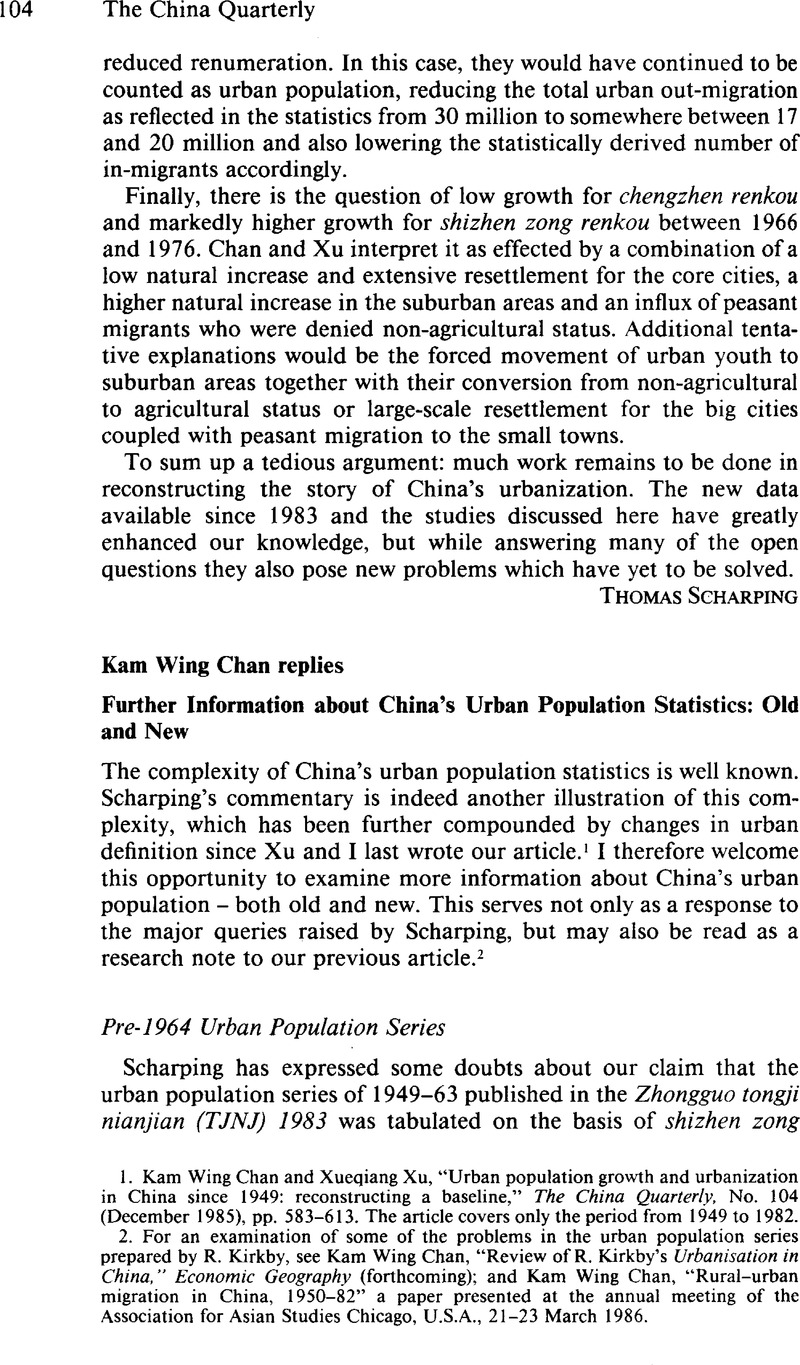Article contents
Kam Wing Chan replies
Further Information about China's Urban Population Statistics: Old and New
Published online by Cambridge University Press: 17 February 2009
Abstract

- Type
- Reply by Kam Wing Chan
- Information
- Copyright
- Copyright © The China Quarterly 1987
References
1. Chan, Kam Wing and Xueqiang, Xu, “Urban population growth and urbanization in China since 1949: reconstructing a baseline,” The China Quarterly, No. 104 (12 1985), pp. 583–613. The article covers only the period from 1949 to 1982.CrossRefGoogle Scholar
2. For an examination of some of the problems in the urban population series prepared by R. Kirkby, see Kam Wing Chan, “Review of R. Kirkby's Urbanisation in China,” Economic Geography (forthcoming); and Kam Wing Chan, “Rural-urban migration in China, 1950–82’ a paper presented at the annual meeting of the Association for Asian Studies Chicago, U.S.A., 21–23 March 1986.
3. Zhongguo tongji nianjian, 1981 (TJNJ, 1981) (Statistical Yearbook of China, 1981) (Beijing: Zhongguo tongji chubanshe, 1982), p. 495.
4. Notice that the Chinese term “chengzhen renkou” can also be used more generally to refer simply to (i) “urban population,” however denned at that time; and not necessarily the narrower meaning of (ii) NPCT, which was first used in 1964 (and till 1982) to define the official urban population. Here the authors refer to definition (i) above. The same interpretation can also be applied to the chengzhen renkou statistics published in the 1950s.
5. Hu, Kaihua and Chen, Wei, “Woguo chengzhen renkou tongji de youguan wenti” (“Questions related to China's urban population statistics”), Renkou yu jingji (Population and Economy), No. 3 (1984), pp. 24 and 39–42.Google Scholar
6. Zhou, Yixing, “Guanyu woguo chengzhenhua de jige wenti” (“Questions related to China's urbanization”), Jingii dili (Economic Geography), No 2 (1984), pp. 116–22;Google ScholarBai, Jianhua, “Woguo chengxiang renkou de zhuangkuang” (“China's urban and rural population”), Renkou yanjiu (Population Studies), No. 2 (1986), pp. 11–14;Google ScholarLi, Chengrui, “Guoji renkou xuehui…”(“International Union for the Scientific Study of Population…“), Renkou yanjiu, No. 6 (1985), p. 5.Google Scholar
7. Zhou Yixing, “Guanyu woguo chengzhenhua,” p. 117.
8. The term “urban administrative area” (UAA) used in this paper does not include suburban counties under urban administration.
9. This might be the reason for the SSB's reluctance to group together in TJNJ 1983, p. 109, the 1953 census urban population totals (77.3 million) with strictly defined administratively urban population figures of the other two censuses.
10. Jiaoqu where farming was the main occupation of the resident population and was not closely linked economically or culturally to the city proper, were considered xiangcun (rural areas). See Zhonghua renmin gongheguo fagui huibian (July-December 1955), pp. 412 and 416–17. It was not common in the early 1950s for urban authorities to designate rural areas under their administration as jiaoxian (suburban counties), which would then be automatically treated as rural areas.
11. See United Nations Population Division, Pattern of Urban and Rural Population Growth (New York: UN, 1980), p. 9.
12. See Kam Wing Chan and Xueqiang Xu, “Urban population growth,” pp. 594–95.
13. Hu and Chen, “China's urban and rural population,” p. 39; TJNJ 1983, p. 103; TJNJ 1984, p. 81.
14. Detailed information about these new criteria can be found in Renmin ribao (People's Daily), 30 November 1984, p. 1.
15. Ye Shunzan, “Current policies and tendency of China's urbanisation,” a paper presented at the Conference on Population Growth, Urbanisation and Urban Policies in the Asia-Pacific Region, 8–12 April, 1985, Honolulu, Hawaii.
16. Examples of these newly created overbounded cities are Yulin, Qinzhou and Bose in Guangxi. See Guangxi jingji nianjian 1985 (Guangxi Economic Yearbook, 1985) (Hong Kong: Jingji daobaoshe, 1985), pp. 458–61.
17. He, Jianchang and Wang, Jiye (eds.). Zhongguo jihua guanli wenti (Questions Related to China's Planning and Management) (Beijing: Zhongguo shehui keshe chubanshe, 1983), p. 548.Google Scholar
18. Hu, Mangzhou, “Solution to the employment problem,” Beijing Review, Vol. 25, No. 39 (27 09 1982), p. 23;Google Scholar He Jianchang and Wang Jiye (eds.), Zhongguo jihua guanli wenti, p. 548.
19. Marc, Blecher, “Peasant labour for urban industry,” World Development, Vol. 11, No. 8 (08 1983), pp. 731–45.Google Scholar
20. Computed from Gu, Shutang et al. (eds.), Tianjin jingji gaikuang (A Survey of Tianjin's Economy) (Tianjin: Tianjin renmin chubanshe, 1984), pp. 460–61.Google Scholar
21. Xu, Jianchuan. “Woguo chengshi de zhuangkuan yu fazhan” (“China's cities and their development”), Jianzhu jingji (Architecture and Economics), No. 5 (1986), p. 33.Google Scholar
22. He Jianchang and Wang Jiye (eds.), Zhongguo jihua guanli wenti, p. 548.
23. For example, the 30 million in-migrants would comprise the following groups: rural migrant labourers working as “temporary” and “contract” workers (13–14 million) and as “both workers and peasants” (the size would be in the order of millions); returnees of rusticated urban youths (3–5 million); returnees of rusticated intellectuals and cadres (in millions); dependants of the various groups (in millions). See Chan and Xu, “Urban population growth,” pp. 606–609.
24. See Kam Wing Chan and Xueqiang Xu, “Urban population growth,” p. 602, footnote 60 (ii).
- 10
- Cited by




